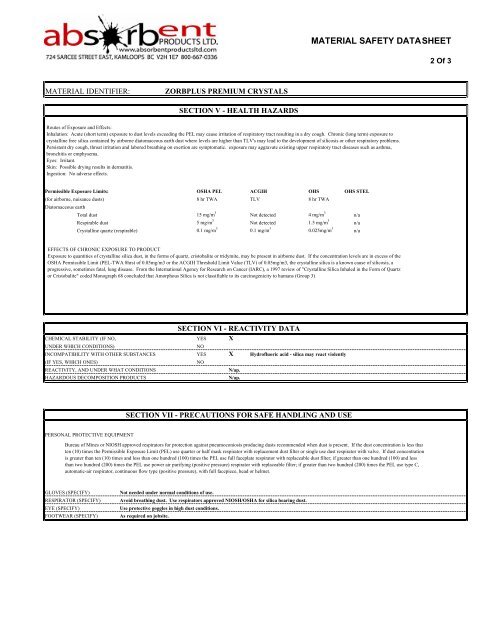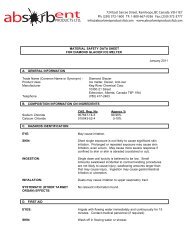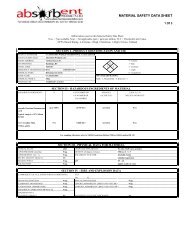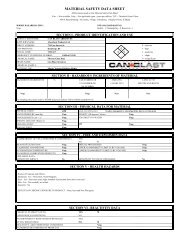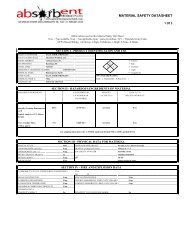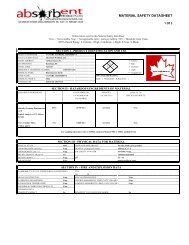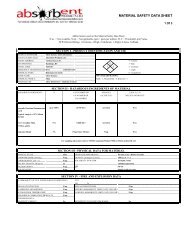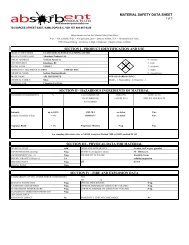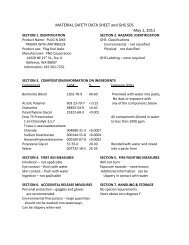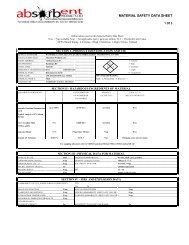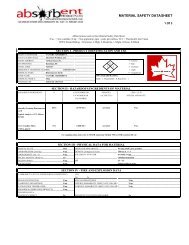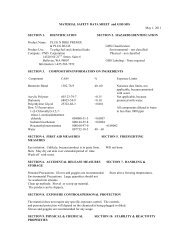MSDS - Zorb Plus Premium Crystals - Absorbent Products Ltd
MSDS - Zorb Plus Premium Crystals - Absorbent Products Ltd
MSDS - Zorb Plus Premium Crystals - Absorbent Products Ltd
You also want an ePaper? Increase the reach of your titles
YUMPU automatically turns print PDFs into web optimized ePapers that Google loves.
MATERIAL SAFETY DATA SHEET<br />
2 Of 3<br />
MATERIAL IDENTIFIER:<br />
ZORBPLUS PREMIUM CRYSTALS<br />
SECTION V - HEALTH HAZARDS<br />
Routes of Exposure and Effects:<br />
Inhalation: Acute (short term) exposure to dust levels exceeding the PEL may cause irritation of respiratory tract resulting in a dry cough. Chronic (long term) exposure to<br />
crystalline free silica contained by airborne diatomaceous earth dust where levels are higher than TLV's may lead to the development of silicosis or other respiratory problems.<br />
Persistent dry cough, throat irritation and labored breathing on exertion are symptomatic. exposure may aggravate existing upper respiratory tract diseases such as asthma,<br />
bronchitis or emphysema.<br />
Eyes: Irritant.<br />
Skin: Possible drying results in dermatitis.<br />
Ingestion: No adverse effects.<br />
Permissible Exposure Limits: OSHA PEL ACGIH OHS OHS STEL<br />
(for airborne, nuisance dusts) 8 hr TWA TLV 8 hr TWA<br />
Diatomaceous earth<br />
Total dust 15 mg/m 3 Not detected 4 mg/m 3 n/a<br />
Respirable dust 5 mg/m 3 Not detected 1.5 mg/m 3 n/a<br />
Crystalline quartz (respirable) 0.1 mg/m 3 0.1 mg/m 3 0.025mg/m 3 n/a<br />
EFFECTS OF CHRONIC EXPOSURE TO PRODUCT<br />
Exposure to quantities of crystalline silica dust, in the forms of quartz, cristobalite or tridymite, may be present in airborne dust. If the concentration levels are in excess of the<br />
OSHA Permissible Limit (PEL-TWA 8hrs) of 0.05mg/m3 or the ACGIH Threshold Limit Value (TLV) of 0.05mg/m3, the crystalline silica is a known cause of silicosis, a<br />
progressive, sometimes fatal, lung disease. From the International Agency for Research on Cancer (IARC), a 1997 review of "Crystalline Silica Inhaled in the Form of Quartz<br />
or Cristobalite" coded Monograph 68 concluded that Amorphous Silica is not classifiable to its carcinogenicity to humans (Group 3)<br />
SECTION VI - REACTIVITY DATA<br />
CHEMICAL STABILITY (IF NO, YES X<br />
UNDER WHICH CONDITIONS)<br />
NO<br />
INCOMPATIBILITY WITH OTHER SUBSTANCES YES X Hydrofluoric acid - silica may react violently<br />
(IF YES, WHICH ONES)<br />
NO<br />
REACTIVITY, AND UNDER WHAT CONDITIONS<br />
N/ap.<br />
HAZARDOUS DECOMPOSITION PRODUCTS<br />
N/ap.<br />
SECTION VII - PRECAUTIONS FOR SAFE HANDLING AND USE<br />
PERSONAL PROTECTIVE EQUIPMENT<br />
Bureau of Mines or NIOSH approved respirators for protection against pneumoconiosis producing dusts recommended when dust is present. If the dust concentration is less than<br />
ten (10) times the Permissible Exposure Limit (PEL) use quarter or half mask respirator with replacement dust filter or single use dust respirator with valve. If dust concentration<br />
is greater than ten (10) times and less than one hundred (100) times the PEL use full faceplate respirator with replaceable dust filter; if greater than one hundred (100) and less<br />
than two hundred (200) times the PEL use power air purifying (positive pressure) respirator with replaceable filter; if greater than two hundred (200) times the PEL use type C,<br />
automatic-air respirator, continuous flow type (positive pressure), with full facepiece, head or helmet.<br />
GLOVES (SPECIFY)<br />
RESPIRATOR (SPECIFY)<br />
EYE (SPECIFY)<br />
FOOTWEAR (SPECIFY)<br />
Not needed under normal conditions of use.<br />
Avoid breathing dust. Use respirators approved NIOSH/OSHA for silica bearing dust.<br />
Use protective goggles in high dust conditions.<br />
As required on jobsite.


